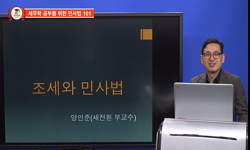This study established a user cost of housing capital estimation formula in line with South Korea’s unique housing market structure and complicated reality taxation, and analyzed a clear cost effect according to the tax system. It was found that the...
http://chineseinput.net/에서 pinyin(병음)방식으로 중국어를 변환할 수 있습니다.
변환된 중국어를 복사하여 사용하시면 됩니다.
- 中文 을 입력하시려면 zhongwen을 입력하시고 space를누르시면됩니다.
- 北京 을 입력하시려면 beijing을 입력하시고 space를 누르시면 됩니다.

세제개편이 주택자산의 자본의 사용자비용에 미치는 효과 = The Effect of Tax Reform on the User Costs of Housing Capital in Korea
한글로보기부가정보
다국어 초록 (Multilingual Abstract)
It was found that the user cost of housing capital was the most significantly influenced by housing price increase rates and rent increase rates, and when these prices surged, it generally showed minus values. The user cost of capital for middle-class people owning a home was not significantly influenced due to low average effective tax rates.
The rental cost of capital has a negative correlation with the income marginal tax rates, and a positive correlation with the transfer marginal tax rates;this correlation becomes more distinctive as the income tax’s and capital gain tax’s marginal tax rates increase. However, in 1997 when an economic crisis hit the country, the effects of income tax and capital gain tax turned out the other way around. Specifically, although the income marginal tax rate increased or the capital gain marginal tax rate decreased, the rental cost of capital rose. Another particular point is that the cost effect according to the same income tax rate changes was greater in lower transfer tax rates, and that the cost effect of the same transfer tax rate changes was greater in the higher income tax rates. Thus, if the government intends to use its taxation policy in changing the cost effect of the rental housing suppliers, when it is deemed that the rental housing suppliers’ income marginal tax rates and transfer tax rates are higher, it would be more effective to choose the transfer tax system than the income tax system. On the other hand, if the income tax rates and the transfer tax rates are deemed lower, the adjustment of the income tax system should be first considered.
The cost effects according to tax reform are summarized as follows. The transfer tax support policy for registered rental housing suppliers, in the period of 1986~2001, decreased the rental cost of capital(RC1) by 2.8~3.1%p. The transfer tax revision and the adoption of the comprehensive real estate holding tax in 2003 and 2005 increased the rental cost of capital(RC1~RC3) by 0.75~1.55%p according to rental housing supplier types.
This study found that the estimated rental cost of capital was considerably correlated with the new housing construction quantity. Thus, this study will allow the government to change the capital cost of house assets through tax policy, thus contributing to stably securing the residential service supply.
This study established a user cost of housing capital estimation formula in line with South Korea’s unique housing market structure and complicated reality taxation, and analyzed a clear cost effect according to the tax system.
It was found that the user cost of housing capital was the most significantly influenced by housing price increase rates and rent increase rates, and when these prices surged, it generally showed minus values. The user cost of capital for middle-class people owning a home was not significantly influenced due to low average effective tax rates.
The rental cost of capital has a negative correlation with the income marginal tax rates, and a positive correlation with the transfer marginal tax rates;this correlation becomes more distinctive as the income tax’s and capital gain tax’s marginal tax rates increase. However, in 1997 when an economic crisis hit the country, the effects of income tax and capital gain tax turned out the other way around. Specifically, although the income marginal tax rate increased or the capital gain marginal tax rate decreased, the rental cost of capital rose. Another particular point is that the cost effect according to the same income tax rate changes was greater in lower transfer tax rates, and that the cost effect of the same transfer tax rate changes was greater in the higher income tax rates. Thus, if the government intends to use its taxation policy in changing the cost effect of the rental housing suppliers, when it is deemed that the rental housing suppliers’ income marginal tax rates and transfer tax rates are higher, it would be more effective to choose the transfer tax system than the income tax system. On the other hand, if the income tax rates and the transfer tax rates are deemed lower, the adjustment of the income tax system should be first considered.
The cost effects according to tax reform are summarized as follows. The transfer tax support policy for registered rental housing suppliers, in the period of 1986~2001, decreased the rental cost of capital(RC1) by 2.8~3.1%p. The transfer tax revision and the adoption of the comprehensive real estate holding tax in 2003 and 2005 increased the rental cost of capital(RC1~RC3) by 0.75~1.55%p according to rental housing supplier types.
This study found that the estimated rental cost of capital was considerably correlated with the new housing construction quantity. Thus, this study will allow the government to change the capital cost of house assets through tax policy, thus contributing to stably securing the residential service supply.
국문 초록 (Abstract)
분석 결과 일반적으로 주택자산에 대한 자본의 사용자비용은 주택가격 상승률 및 임대료 상승률에 가장 큰 영향을 받고, 이들 가격이 급격히 상승하던 시기에 일반적으로 부(-)의 값을 갖는 것으로 나타났다. 중산층의 자가보유점유가구 자본의 사용자비용은 낮은 평균실효세율로 인해 부동산 관련세제에 큰 영향을 받지 않았다.
임대주택 공급자 자본의 임대비용 추계 결과는 1984년 이후 자가보유점유가구 자본의 사용자비용에 비해 전체적으로 10% 미만에서 안정적이다. 자본의 임대비용은 소득세 한계세율과 음의 상관관계를, 양도세 한계세율과는 정의 상관관계를 갖고, 소득세와 자본이득세 한계세율이 높을수록 이런관계가 명확해진다. 하지만 1997년 경제위기는 소득세와 자본이득세 효과가 이와는 반대로 나타나기도 하였다. 즉, 소득세 한계세율이 높아지거나 자본이득세 한계세율이 낮아져도 자본의 임대비용이 상승하였다. 다른 하나의 특이점은 동일한 소득세율 변화에 따른 비용효과는 낮은 양도세율하에서 더 크게, 동일한 양도세율 변화의 비용효과는 높은 소득세율 하에서 더 크게 나타났다. 따라서 정부가 조세정책을 이용하여 임대주택 공급자의 비용효과에 변화를 주고자 한다면, 임대주택 공급자의소득세 한계세율 및 양도세율이 높다고 판단될 경우 소득세제보다는 양도세제를 선택하는 것이 더 효과적일 것이다. 반면, 소득세율과 양도세율이 비교적 낮다고 판단되어지면 소득세제를 조정하는 것이 우선 고려되어야 할 것이다.
세제에 따른 유형별 임대주택 공급자의 주택자산에 대한 비용 효과는 상이한 것으로 나타났다. 먼저 임대주택등록사업자는 양도소득세와 소득세제 등 조세지원제도에 가장 큰 영향을 받는 것으로 나타났다. 다음으로 부유한 비등록임대주택공급자는 소득세 효과가 큰 것으로 나타났다. 특히 다주택자에게 세법상의 다양한 양도세 비과세 감면 혜택이 주어지고 실질과세가 어렵다는 점에서 정부의 등록임대주택사업자에 대한 다양한 세제상의 지원은 이들에게 의미 있는 영향을 주지 못하는 것으로 나타났다.
세제개편에 따른 비용효과를 요약하면, 등록임대주택사업자에 대한 1986~2001년 기간 양도세제지원 정책은 자본의 임대비용 RC1을 2.8~3.1%p 감소시켰다. 2003년과 2005년 양도세제 개편과 종부세 도입은 임대주택 공급자 유형별로 자본의 임대비용(RC1~RC3)을 약 0.75~1.55%p 증가시킨 것으로 나타났다.
본 연구에서 추정한 자본의 임대비용은 신규주택 건설량과 상당한 연관이 있는 것으로 나타났다. 따라서 본 연구의 결과는 정부가 조세정책을 통해 주택자산의 자본비용을 변화시킴으로써 안정적인주거서비스 공급을 확보하는데 일정 기여할 수 있을 것이다.
본 연구는 우리나라의 독특한 주택시장 구조와 복잡한 부동산 관련 세제에 맞는 주택자산에 대한 자본의 사용자비용 추정식을 설정하고 조세제도에 따른 명확한 비용효과를 분석하였다. 분...
본 연구는 우리나라의 독특한 주택시장 구조와 복잡한 부동산 관련 세제에 맞는 주택자산에 대한 자본의 사용자비용 추정식을 설정하고 조세제도에 따른 명확한 비용효과를 분석하였다.
분석 결과 일반적으로 주택자산에 대한 자본의 사용자비용은 주택가격 상승률 및 임대료 상승률에 가장 큰 영향을 받고, 이들 가격이 급격히 상승하던 시기에 일반적으로 부(-)의 값을 갖는 것으로 나타났다. 중산층의 자가보유점유가구 자본의 사용자비용은 낮은 평균실효세율로 인해 부동산 관련세제에 큰 영향을 받지 않았다.
임대주택 공급자 자본의 임대비용 추계 결과는 1984년 이후 자가보유점유가구 자본의 사용자비용에 비해 전체적으로 10% 미만에서 안정적이다. 자본의 임대비용은 소득세 한계세율과 음의 상관관계를, 양도세 한계세율과는 정의 상관관계를 갖고, 소득세와 자본이득세 한계세율이 높을수록 이런관계가 명확해진다. 하지만 1997년 경제위기는 소득세와 자본이득세 효과가 이와는 반대로 나타나기도 하였다. 즉, 소득세 한계세율이 높아지거나 자본이득세 한계세율이 낮아져도 자본의 임대비용이 상승하였다. 다른 하나의 특이점은 동일한 소득세율 변화에 따른 비용효과는 낮은 양도세율하에서 더 크게, 동일한 양도세율 변화의 비용효과는 높은 소득세율 하에서 더 크게 나타났다. 따라서 정부가 조세정책을 이용하여 임대주택 공급자의 비용효과에 변화를 주고자 한다면, 임대주택 공급자의소득세 한계세율 및 양도세율이 높다고 판단될 경우 소득세제보다는 양도세제를 선택하는 것이 더 효과적일 것이다. 반면, 소득세율과 양도세율이 비교적 낮다고 판단되어지면 소득세제를 조정하는 것이 우선 고려되어야 할 것이다.
세제에 따른 유형별 임대주택 공급자의 주택자산에 대한 비용 효과는 상이한 것으로 나타났다. 먼저 임대주택등록사업자는 양도소득세와 소득세제 등 조세지원제도에 가장 큰 영향을 받는 것으로 나타났다. 다음으로 부유한 비등록임대주택공급자는 소득세 효과가 큰 것으로 나타났다. 특히 다주택자에게 세법상의 다양한 양도세 비과세 감면 혜택이 주어지고 실질과세가 어렵다는 점에서 정부의 등록임대주택사업자에 대한 다양한 세제상의 지원은 이들에게 의미 있는 영향을 주지 못하는 것으로 나타났다.
세제개편에 따른 비용효과를 요약하면, 등록임대주택사업자에 대한 1986~2001년 기간 양도세제지원 정책은 자본의 임대비용 RC1을 2.8~3.1%p 감소시켰다. 2003년과 2005년 양도세제 개편과 종부세 도입은 임대주택 공급자 유형별로 자본의 임대비용(RC1~RC3)을 약 0.75~1.55%p 증가시킨 것으로 나타났다.
본 연구에서 추정한 자본의 임대비용은 신규주택 건설량과 상당한 연관이 있는 것으로 나타났다. 따라서 본 연구의 결과는 정부가 조세정책을 통해 주택자산의 자본비용을 변화시킴으로써 안정적인주거서비스 공급을 확보하는데 일정 기여할 수 있을 것이다.
참고문헌 (Reference)
1 表鶴吉, "한국의 산업별? 자산별 자본스톡추계(1953~2000)" 한국경제의 분석패널 9 (9): 203-274, 2003
2 한국은행, "한국의 국민대차대조표 해설"
3 국세청, "지방세정연감"
4 김관영, "중산층 주거생활안정을 위한 정책방안연구" 10 (10): 115-132, 1988
5 대한주택공사, "주택통계편람"
6 황의선, "주택자금 수요예측모형에 관한 연구;민영주택자금을 중심으로" 116 (116): 16-33, 1990
7 황규영, "주택의 간주임대료에 관한 세법규정의 개선방안" 한국세무학회 12 (12): 461-487, 2011
8 국토해양부, "주택업무편람"
9 이중희, "주택경제론" 박영사 1997
10 국통해양부, "주거실태조사" 2008
1 表鶴吉, "한국의 산업별? 자산별 자본스톡추계(1953~2000)" 한국경제의 분석패널 9 (9): 203-274, 2003
2 한국은행, "한국의 국민대차대조표 해설"
3 국세청, "지방세정연감"
4 김관영, "중산층 주거생활안정을 위한 정책방안연구" 10 (10): 115-132, 1988
5 대한주택공사, "주택통계편람"
6 황의선, "주택자금 수요예측모형에 관한 연구;민영주택자금을 중심으로" 116 (116): 16-33, 1990
7 황규영, "주택의 간주임대료에 관한 세법규정의 개선방안" 한국세무학회 12 (12): 461-487, 2011
8 국토해양부, "주택업무편람"
9 이중희, "주택경제론" 박영사 1997
10 국통해양부, "주거실태조사" 2008
11 곽태원, "조세론" 법문사 2001
12 통계청, "인구주택총조사"
13 최영걸, "서울시 주택시장에서 작동되는 가격기대심리에 관한 실증연구" 대한국토·도시계획학회 39 (39): 131-141, 2004
14 김성배, "사용자비용의 활용과 그 활용에 관하여" 132 : 36-40, 1992
15 김재형, "부동산정책의 종합적 검토와 발전방향 모색" 한국개발연구원 2008
16 조주현, "부동산시장 분석론" 부연사 2006
17 박재환, "부동산 양도소득세제의 평가와 개편방안-주택을 중심으로-" 한국세무학회 25 (25): 191-221, 2008
18 이진순, "부동산 보유과세제도의 개편방안에 관한연구" 재정경제부 2003
19 김경환, "도시경제" 홍문사 2002
20 국세청, "국세통계연보"
21 김완석, "개인소득세제의 평가와 개편방향" 13 : 101-140, 1999
22 Denise DiPasquale, "Urban Economics and Real Estate Markets" Prentice-Hall, Inc 1996
23 Hendershott P. H., "The economics of tenure choice:1955~79" NBER 1980
24 Denise DiPasquale, "The Cost of Capital, Tax Reform, and the Future of the Rental Housing Market" 31 (31): 337-359, 1992
25 Hendershott P. H., "Research in Real Estate" Jai Press 105-133, 1982
동일학술지(권/호) 다른 논문
-
- 한국세무학회
- 구자은
- 2016
- KCI등재
-
이전가격세제와 부가가치세제의 조화방안 - 국외특수관계인으로부터의 용역 수입을 중심으로 -
- 한국세무학회
- 박설아
- 2016
- KCI등재
-
비즈니스 사이클 및 투자자 심리와 한계세율이 투자, 고용 및 자본조달에 미치는 영향
- 한국세무학회
- 김준원
- 2016
- KCI등재
-
- 한국세무학회
- 고윤성
- 2016
- KCI등재
분석정보
인용정보 인용지수 설명보기
학술지 이력
| 연월일 | 이력구분 | 이력상세 | 등재구분 |
|---|---|---|---|
| 2027 | 평가예정 | 재인증평가 신청대상 (재인증) | |
| 2021-01-01 | 평가 | 등재학술지 유지 (재인증) |  |
| 2018-01-01 | 평가 | 등재학술지 유지 (등재유지) |  |
| 2015-01-01 | 평가 | 등재학술지 유지 (등재유지) |  |
| 2011-01-01 | 평가 | 등재학술지 유지 (등재유지) |  |
| 2009-01-01 | 평가 | 등재학술지 유지 (등재유지) |  |
| 2007-01-01 | 평가 | 등재학술지 유지 (등재유지) |  |
| 2004-01-01 | 평가 | 등재학술지 선정 (등재후보2차) |  |
| 2003-01-01 | 평가 | 등재후보 1차 PASS (등재후보1차) |  |
| 2002-01-01 | 평가 | 등재후보학술지 유지 (등재후보1차) |  |
| 1999-07-01 | 평가 | 등재후보학술지 선정 (신규평가) |  |
학술지 인용정보
| 기준연도 | WOS-KCI 통합IF(2년) | KCIF(2년) | KCIF(3년) |
|---|---|---|---|
| 2016 | 0.98 | 0.98 | 1.03 |
| KCIF(4년) | KCIF(5년) | 중심성지수(3년) | 즉시성지수 |
| 1.37 | 1.48 | 1.713 | 0.03 |




 KCI
KCI 스콜라
스콜라






